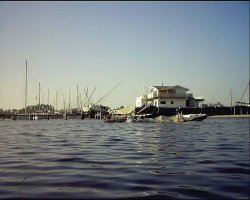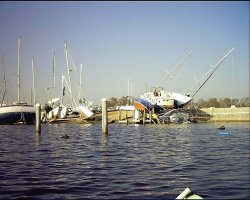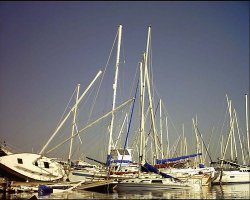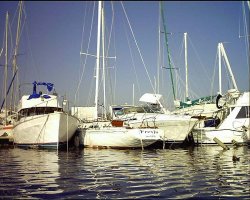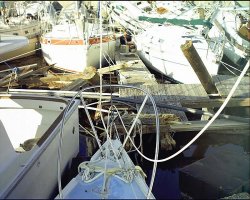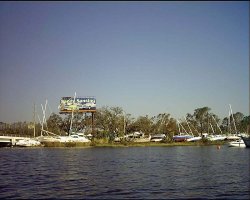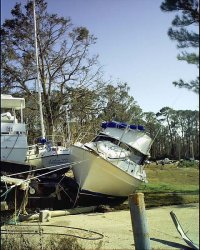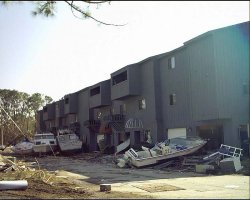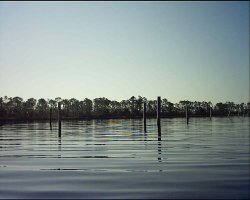Good point Morgan, it is worth filing some lessons learned.
To start with I will answer Loren's question: there was a storm surge of about 15 ft inside the Bayou Grande. Pensacola Bay is protected by a barrier island (which took 40ft breakers, and a lot of which is gone), but the water pushed ahead of the storm rose 15 ft in the protected inlets, one of which is the Bayou Grande (another is the Bayou Chico, where the white trash yacht club is). The pictures of boats on dry land are the result of the 15 ft tide, the buildings shown had their entire lower floors washed out. Elsewhere I have seen building that collapsed. The last picture is about 200 yds inland.
I was unable to leave the dock as I was working on my engine at the time. I put two 3/4" nylon twisted lines with chafing protection to each corner the way I had before for tropical storms (visible in the pictures), plus I then dropped both my good anchors using my canoe, a 35lb CQR with 35 ft of 3/8" (I think) chain then 5/8" nylon twisted off the stern, FX23 with all chain off the bow. I tied off the boom and rudder, then took just about everything that was removable from the boat.
I dropped an anchor for one of my neighbours, then we held a ceremony to Njord with champagne and left.
The two anchored boats were at the outside of the pile on the seawall when we returned. The picture below shows the pilings from the floating dock, which leaves me figuring that the dock, once it had risen over the pilings, started to drift, was held briefly by the anchors during which time it flipped around, then the anchor rodes broke and the dock broke apart - the boats directly opposite me, which had been further from the sea wall, ended up smashed to bits inside the boats next to me, but protected us from the concrete. The boats more than 5-6 slips down ended up the far side of the bay in the later pictures.
The boats on moorings or at anchor in the bay were all taken out by the drifting boats from my dock and wound up on shore with them; except for one, which was flying full colours the next day while the rest of us were searching the bay for our boats.
If there is a next time, I will find the best spot I can away from other boats (Ray, a lot of boaters in Pensacola agree with you), drop the two largest anchors I can find with ridiculously oversized rodes to the cleats I installed with a lot of reinforcing glass, and then leave. A lot of boaters like to stay with their boats to fend off others careening towards them, I might be tempted in lower catagory storms, but in something the size of what just hit Pensacola, NO WAY IN HELL. There is not much you can do to save your boat in 130+ mph winds, horizontal rain/spray, and wild waves; one of the blessings of living in the 21st century is that we get plenty of warning of these storms and have plenty of transport to go somewhere else fast. This may seem stating the obvious, but 5 dead bodies were pulled from the water just up the Bayou from where the pictures were taken.
I appreciate the messages from the only people who can understand (other Ericson owners), I will save her if the insurance company let me. Most of the deck hardware is destroyed, along with the deck under it, the boom is gone, a couple of the shrouds are gone, the engine was flooded, but my biggest concern is the crush damage to the main bulkheads from the boats I was sandwiched inbetween. I need a surveyor to look at that. So you may see questions from me in the future on these subjects, plus I will give updates on how it works with the insurance. To complicate things, my employment is about to take me elsewhere, although that may be a blessing since every boat yard in Florida will be packed for a long time to come.
The photo I did not include was the nice looking Ericson 32 owned by a friendly retired chaplain and his wife - we could only find half their boat.
Enough gloom from me, I will sign off.
Gareth
Freyja E35 #241 1972

